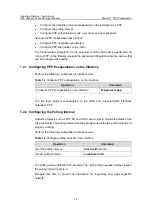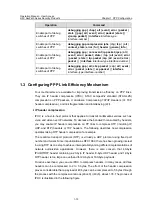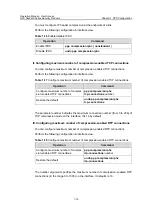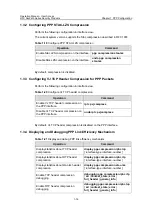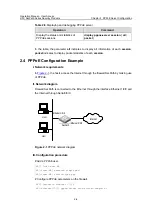
Operation Manual – User Access
H3C SecPath Series Security Products
Chapter 1 PPP Configuration
1-10
Table 1-11
Assign an IP address for the PPP user using the address pool for the
domain
Operation
Command
Define a global IP address pool
ip pool
pool-number low-ip-address
[
high-ip-address
]
Remove the configuration
undo
ip
pool
pool-number
Assign an IP address for the PPP user
using the global IP address pool
remote
address
pool
[
pool-number
]
Remove the configuration
undo
remote
address
By default, if the
remote
address
pool
command and the domain address pool are not
configured, the IP address is not assigned for the peer.
The following section describes how to assign an IP address for the PPP user:
1) For the domain user (including
userid
and
userid@isp-name
), assign the IP
address as follows:
z
In the case of RADIUS or TACACS authentication and authorization, when the
server delivers an IP address for the PPP user, the delivered IP address is used.
z
If the server delivers an IP address pool instead of an IP address, the system
searches for the IP address pool in turn in domain view, and assigns an IP address
for the PPP user.
z
If the system assigns no IP address using the above two methods, or the local
authentication is adopted, the system searches for the address pool in turn in
domain view, and assigns an IP address for the PPP user.
2) For users not to be authenticated, the system uses the specified global address
pool (the address pool defined in system view) on the interface to assign an IP
address for the PPP user.
When directly specifying the IP address for the peer on the interface or uses the global
address pool to assign the IP address, the system allows the peer to use its
self-configured IP address after the
remote address
command is configured; if the
system does not want (or allow) the peer to use its self-configured IP address, and
orders the peer to receive the IP address assigned by the local user, you must
configure the peer IP address assigned by negotiation and execute the following
commands in interface view on server side.





